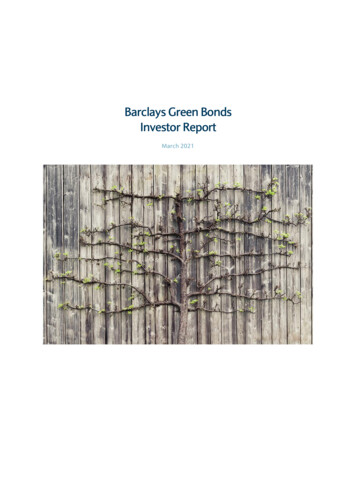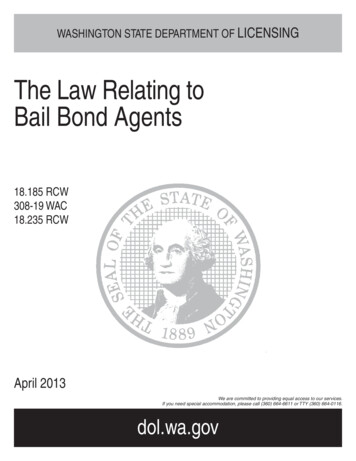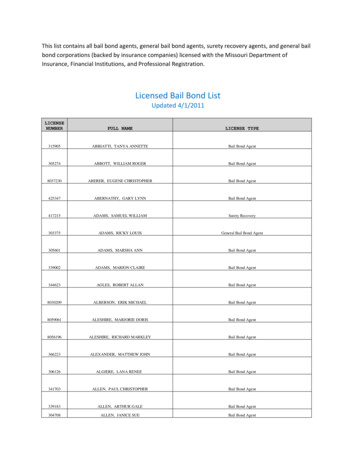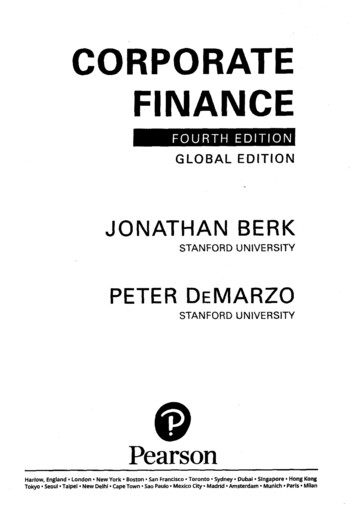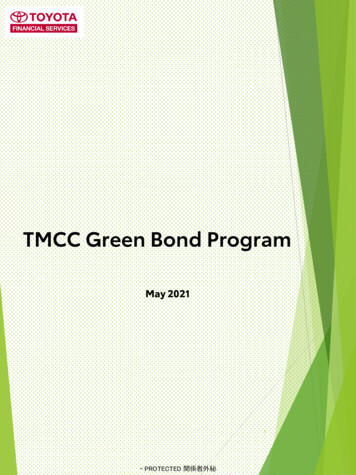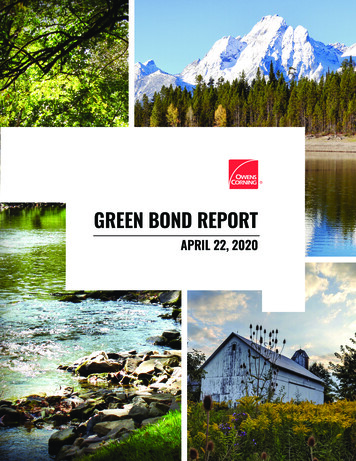
Transcription
Green Bond PrinciplesVoluntary Process Guidelines for Issuing Green BondsJune 2021
June 2021Green Bond PrinciplesVoluntary Process Guidelines forIssuing Green BondsIntroductionThe Green Bond Principles (GBP), together with the Social Bond Principles (SBP),the Sustainability Bond Guidelines (SBG) and the Sustainability-Linked BondPrinciples (SLBP) are published under the governance of the Principles. The Principlesare a collection of voluntary frameworks with the stated mission and vision of promotingthe role that global debt capital markets can play in financing progress towardsenvironmental and social sustainability.The Principles outline best practices when issuing bonds serving social and/orenvironmental purposes through global guidelines and recommendations that promotetransparency and disclosure, thereby underpinning the integrity of the market. ThePrinciples also raise awareness of the importance of environmental and social impactamong financial market participants, which ultimately aims to attract more capital tosupport sustainable development.The GBP seek to support issuers in financing environmentally sound and sustainableprojects that foster a net-zero emissions economy and protect the environment. GBPaligned issuance should provide transparent green credentials alongside an investmentopportunity. By recommending that issuers report on the use of Green Bond proceeds,the GBP promote a step change in transparency that facilitates the tracking of fundsto environmental projects, while simultaneously aiming to improve insight into theirestimated impact.The GBP provide high level categories for eligible Green Projects in recognition of thediversity of current views and of the ongoing development in the understanding ofenvironmental issues and consequences, while referring when needed to other partiesthat provide complementary definitions, standards and taxonomies for determiningthe environmental sustainability of projects. The GBP encourage all participants inthe market to use this foundation to develop their own robust practices, referencing abroad set of complementary criteria as relevant.The GBP are collaborative and consultative in nature based on the contributionsof Members and Observers of the Principles, and of the wider community ofstakeholders. They are updated as required in order to reflect the development andgrowth of the global Green Bond market. The GBP, and the Principles generally, arecoordinated by the Executive Committee with the support of the Secretariat.In addition to the GBP, the Principles offer approaches that reflect issuer levelsustainability commitments, which can supplement or provide an alternative to a focuson use of proceeds. Such commitments can be expressed through SustainabilityLinked Bonds, as well as through dedicated issuer strategies and disclosures asrecommended by the Climate Transition Finance Handbook when communicatingParis-aligned transition plans. An illustration of the products and related guidancecovered by the Principles is depicted in Appendix II.2
Voluntary Process Guidelinesfor Issuing Green BondsThe 2021 Edition of the GBPGreen Bond DefinitionThis edition of the GBP benefits from the feedback of the 2020consultation of the Members and Observers of the Principles,the Advisory Council, as well as from the input of the workinggroups coordinated by the Executive Committee with thesupport of the Secretariat.Green Bonds are any type of bond instrument where theproceeds or an equivalent amount will be exclusively appliedto finance or re-finance, in part or in full, new and/or existingeligible Green Projects (see Use of Proceeds section below) andwhich are aligned with the four core components of the GBP.Notably, the 2021 edition of the GBP identifies keyrecommendations regarding Green Bond Frameworks andExternal Reviews alongside the four core components of theGBP. It recommends heightened transparency for issuer-levelsustainability strategies and commitments, and encouragesinformation, if relevant, on the degree of alignment of projectswith official or market-based taxonomies.Different types of Green Bonds exist in the market. These aredescribed in Appendix I.Further, it provides guidance on issuer processes to identifymitigants to known material risks of negative social and/orenvironmental impacts. It also contains additional clarificationsand updates relating to recommended market practice.This edition otherwise includes important references tocomplementary guidance from the Principles included in theClimate Transition Finance Handbook, the HarmonisedFramework for Impact Reporting and the Guidelines forExternal Reviews, which are supplemented by the GuidanceHandbook.It is understood that certain eligible Green Projects may havesocial co-benefits, and that the classification of a use ofproceeds bond as a Green Bond should be determined bythe issuer based on its primary objectives for the underlyingprojects. (bonds that intentionally mix eligible Green and SocialProjects are referred to as Sustainability Bonds, and specificguidance for these is provided separately in the SustainabilityBond Guidelines).It is important to note that Green Bonds should not beconsidered fungible with bonds that are not aligned with thefour core components of the GBP. Bonds issued under earlierGreen Bond Guidance released prior to this version are deemedconsistent with the GBP.3
Voluntary Process Guidelinesfor Issuing Green BondsGreen Bond PrinciplesThe Green Bond Principles (GBP) are voluntary processguidelines that recommend transparency and disclosureand promote integrity in the development of the Green Bondmarket by clarifying the approach for issuance of a GreenBond. The GBP are intended for broad use by the market:they provide issuers with guidance on the key componentsinvolved in launching a credible Green Bond; they aid investorsby promoting availability of information necessary to evaluatethe environmental impact of their Green Bond investments; andthey assist underwriters by offering vital steps that will facilitatetransactions that preserve the integrity of the market.The GBP recommend a clear process and disclosure for issuers,which investors, banks, underwriters, arrangers, placementagents and others may use to understand the characteristicsof any given Green Bond. The GBP emphasise the requiredtransparency, accuracy and integrity of the information that willbe disclosed and reported by issuers to stakeholders throughcore components and key recommendations.The four core components for alignment with the GBP are:1. Use of Proceeds2. Process for Project Evaluation and Selection3. Management of Proceeds4. ReportingThe key recommendations for heightened transparency are:(i) Green Bond Frameworks(ii) External Reviews1. Use of ProceedsThe cornerstone of a Green Bond is the utilisation of theproceeds of the bond for eligible Green Projects, which shouldbe appropriately described in the legal documentation of thesecurity. All designated eligible Green Projects should provideclear environmental benefits, which will be assessed and, wherefeasible, quantified by the issuer.In the event that all or a proportion of the proceeds are or maybe used for refinancing, it is recommended that issuers providean estimate of the share of financing vs. re-financing, and whereappropriate, also clarify which investments or project portfoliosmay be refinanced, and, to the extent relevant, the expectedlook-back period for refinanced eligible Green Projects.The GBP explicitly recognise several broad categories ofeligibility for Green Projects, which contribute to environmentalobjectives such as: climate change mitigation, climate changeadaptation, natural resource conservation, biodiversityconservation, and pollution prevention and control.The following list of project categories, while indicative, capturesthe most commonly used types of projects supported, orexpected to be supported the Green Bond market. GreenProjects include assets, investments and other related andsupporting expenditures such as R&D that may relate to morethan one category and/or environmental objective. Threeenvironmental objectives identified above (pollution preventionand control, biodiversity conservation and climate changeadaptation) also serve as project categories in the list. As such,they refer to the projects that are more specifically designed tomeet these environmental objectives.The eligible Green Projects categories, listed in no specific order,include, but are not limited to: Renewable energy (including production, transmission,appliances and products); Energy efficiency (such as in new and refurbished buildings,energy storage, district heating, smart grids, appliances andproducts); Pollution prevention and control (including reduction of airemissions, greenhouse gas control, soil remediation, wasteprevention, waste reduction, waste recycling and energy/emission-efficient waste to energy); Environmentally sustainable management of livingnatural resources and land use (including environmentallysustainable agriculture; environmentally sustainable animalhusbandry; climate smart farm inputs such as biologicalcrop protection or drip-irrigation; environmentally sustainable4
Voluntary Process Guidelinesfor Issuing Green Bondsfishery and aquaculture; environmentally sustainable forestry,including afforestation or reforestation, and preservation orrestoration of natural landscapes);2. Process for Project Evaluation and Selection Terrestrial and aquatic biodiversity conservation(including the protection of coastal, marine and watershedenvironments); The environmental sustainability objectives of the eligibleGreen Projects; Clean transportation (such as electric, hybrid, public, rail,non-motorised, multi-modal transportation, infrastructure forclean energy vehicles and reduction of harmful emissions); Sustainable water and wastewater management(including sustainable infrastructure for clean and/or drinkingwater, wastewater treatment, sustainable urban drainagesystems and river training and other forms of floodingmitigation); Climate change adaptation (including efforts to makeinfrastructure more resilient to impacts of climate change,as well as information support systems, such as climateobservation and early warning systems);Circular economy adapted products, productiontechnologies and processes (such as the design andintroduction of reusable, recyclable and refurbishedmaterials, components and products; circular tools andservices); and/or certified eco-efficient products;Green buildings that meet regional, national orinternationally recognised standards or certifications forenvironmental performance.While the GBP’s purpose is not to take a position on whichgreen technologies, standards, claims and declarations areoptimal for environmentally sustainable benefits, it is noteworthythat there are several current international and national initiativesto produce taxonomies and nomenclatures, as well as toprovide mapping between them to ensure comparability. Thesemay give further guidance to Green Bond issuers as to whatmay be considered green and eligible by investors. Thesetaxonomies are currently at various stages of development.Issuers and other stakeholders can refer to examples in thesustainable finance section of ICMA’s website.The issuer of a Green Bond should clearly communicate toinvestors: The process by which the issuer determines how theprojects fit within the eligible Green Projects categories(examples are identified above); and Complementary information on processes by whichthe issuer identifies and manages perceived social andenvironmental risks associated with the relevant project(s).Issuers are also encouraged to: Position the information communicated above within thecontext of the issuer’s overarching objectives, strategy, policyand/or processes relating to environmental sustainability. Provide information, if relevant, on the alignment of projectswith official or market-based taxonomies, related eligibilitycriteria, including if applicable, exclusion criteria; and alsodisclose any green standards or certifications referenced inproject selection. Have a process in place to identify mitigants to knownmaterial risks of negative social and/or environmentalimpacts from the relevant project(s). Such mitigants mayinclude clear and relevant trade-off analysis undertaken andmonitoring required where the issuer assesses the potentialrisks to be meaningful.Furthermore, there are many institutions that provideindependent analysis, advice and guidance on the quality ofdifferent green solutions and environmental practices. Definitionsof green and Green Projects may also vary depending on sectorand geography.Finally, where issuers wish to finance projects towardsimplementing a net zero emissions strategy aligned withthe goals of the Paris Agreement, guidance on issuer leveldisclosures and climate transition strategies may be sought fromthe Climate Transition Finance Handbook.5
Voluntary Process Guidelinesfor Issuing Green Bonds3. Management of Proceeds4. ReportingThe net proceeds of the Green Bond, or an amount equal tothese net proceeds, should be credited to a sub-account,moved to a sub-portfolio or otherwise tracked by the issuer inan appropriate manner, and attested to by the issuer in a formalinternal process linked to the issuer’s lending and investmentoperations for eligible Green Projects.Issuers should make, and keep, readily available up to dateinformation on the use of proceeds to be renewed annuallyuntil full allocation, and on a timely basis in case of materialdevelopments. The annual report should include a list of theprojects to which Green Bond proceeds have been allocated, aswell as a brief description of the projects, the amounts allocated,and their expected impact. Where confidentiality agreements,competitive considerations, or a large number of underlyingprojects limit the amount of detail that can be made available,the GBP recommend that information is presented in genericterms or on an aggregated portfolio basis (e.g. percentageallocated to certain project categories).So long as the Green Bond is outstanding, the balance of thetracked net proceeds should be periodically adjusted to matchallocations to eligible Green Projects made during that period.The issuer should make known to investors the intended typesof temporary placement for the balance of unallocated netproceeds.The proceeds of Green Bonds can be managed per bond(bond-by-bond approach) or on an aggregated basis for multiplegreen bonds (portfolio approach).The GBP encourage a high level of transparency andrecommend that an issuer’s management of proceeds besupplemented by the use of an external auditor, or otherthird party, to verify the internal tracking method and theallocation of funds from the Green Bond proceeds (see KeyRecommendations section below).Transparency is of particular value in communicating theexpected and/or achieved impact of projects. The GBPrecommend the use of qualitative performance indicatorsand, where feasible, quantitative performance measuresand disclosure of the key underlying methodology and/orassumptions used in the quantitative determination. Issuersshould refer to and adopt, where possible, the guidance andimpact reporting templates provided in the HarmonisedFramework for Impact Reporting.The use of a summary, which reflects the main characteristicsof a Green Bond or a Green Bond programme, and illustratesits key features in alignment with the four core components ofthe GBP, may help inform market participants. To that end, atemplate can be found in the sustainable finance section ofICMA’s website which once completed can be made availableonline for market information (see Resource Centre sectionbelow).6
Voluntary Process Guidelinesfor Issuing Green BondsKey RecommendationsGreen Bond FrameworksIssuers should explain the alignment of their Green Bond or GreenBond programme with the four core components of the GBP (i.e.Use of Proceeds, Process for Project Evaluation and Selection,Management of Proceeds and Reporting) in a Green BondFramework or in their legal documentation. Such Green BondFramework and/or legal documentation should be available in areadily accessible format to investors.It is recommended that issuers summarise in their Green BondFramework relevant information within the context of the issuer’soverarching sustainability strategy. This may include reference tothe five high level environmental objectives of the GBP (climatechange mitigation, climate change adaptation, natural resourceconservation, biodiversity conservation, and pollution prevention andcontrol). Issuers are also encouraged to disclose any taxonomies,green standards or certifications referenced in project selection.When communicating Paris-aligned transition strategies in thecontext of projects targeting climate change mitigation, issuersare encouraged to use guidance from the Climate TransitionFinance Handbook.External ReviewsIt is recommended that issuers appoint (an) external reviewprovider(s) to assess through a pre-issuance external review thealignment of their Green Bond or Green Bond programme and/or Framework with the four core components of the GBP (i.e.Use of Proceeds, Process for Project Evaluation and Selection,Management of Proceeds and Reporting) as defined above.Post issuance, it is recommended that an issuer’s managementof proceeds be supplemented by the use of an external auditor,or other third party, to verify the internal tracking and theallocation of funds from the Green Bond proceeds to eligibleGreen Projects.The GBP encourage external review providers to disclose theircredentials and relevant expertise and communicate clearly thescope of the review(s) conducted. Issuers should make externalreviews publicly available on their website and/or through anyother accessible communication channel as appropriate andif feasible, as well as use the template for external reviewsavailable in the sustainable finance section of ICMA’s website.Resource CentreRecommended templates and other GBP resources areavailable in the sustainable finance section of ICMA’s website.Completed templates can be made available online for marketinformation at the Resource Centre by following the instructionsat the link above.DisclaimerThe Green Bond Principles are voluntary process guidelinesthat neither constitute an offer to purchase or sell securitiesnor constitute specific advice of whatever form (tax, legal,environmental, accounting or regulatory) in respect of GreenBonds or any other securities. The Green Bond Principles donot create any rights in, or liability to, any person, public orprivate. Issuers adopt and implement the Green Bond Principlesvoluntarily and independently, without reliance on or recourseto the Green Bond Principles, and are solely responsible forthe decision to issue Green Bonds. Underwriters of GreenBonds are not responsible if issuers do not comply with theircommitments to Green Bonds and the use of the resulting netproceeds. If there is a conflict between any applicable laws,statutes and regulations and the guidelines set forth in theGreen Bond Principles, the relevant local laws, statutes andregulations shall prevail.There are a variety of ways for issuers to obtain outside input totheir Green Bond process and there are several types of reviewthat can be provided to the market. Issuers should consult theGuidelines for External Reviews for recommendations andexplanations on the different types of reviews. These Guidelineshave been developed by the GBP to promote best practice.They are a market-based initiative to provide information andtransparency on the external review processes for issuers,underwriters, investors, other stakeholders and externalreviewers themselves.7
Voluntary Process Guidelinesfor Issuing Green BondsAppendix ITypes of Green BondsThere are currently four types of Green Bonds (additionaltypes may emerge as the market develops and these will beincorporated in GBP updates): Standard Green Use of Proceeds Bond: a standardrecourse-to-the-issuer debt obligation aligned with the GBP. Green Revenue Bond: a non-recourse-to-the-issuer debtobligation aligned with the GBP in which the credit exposurein the bond is to the pledged cash flows of the revenuestreams, fees, taxes etc., and whose use of proceeds go torelated or unrelated Green Project(s). Green Project Bond: a project bond for a single or multipleGreen Project(s) for which the investor has direct exposureto the risk of the project(s) with or without potential recourseto the issuer, and that is aligned with the GBP. Green Securitised Bond: a bond collateralised by one ormore specific Green Project(s), including but not limitedto covered bonds, ABS, MBS, and other structures; andaligned with the GBP. The first source of repayment isgenerally the cash flows of the assets.Note 2It is recognised that there is a market of bonds with sustainablethemes which finance a combination of green and socialprojects, including those linked to the Sustainable DevelopmentGoals (“SDGs”). In some cases, such bonds may be issued byorganisations that are mainly or entirely involved in sustainableactivities, but their bonds may not align to the four corecomponents of the GBP. In such cases, investors will needto be informed accordingly and care should be taken to notimply GBP (or SBP) features by a Sustainability Bond or SDGreference. These issuing entities are encouraged to adopt,where possible, the relevant best practice of the GBP andSBP (e.g. for reporting) for such existing sustainability, SDG orotherwise themed bonds, and to align future issues with theGBP and SBP.A mapping of the GBP and SBP to the SustainableDevelopment Goals (SDGs) is available and aims to provide abroad frame of reference by which issuers, investors and marketparticipants can evaluate the financing objectives of a givenGreen, Social or Sustainability Bond/Bond Programme againstthe SDGs. It can be found in the sustainable finance sectionof ICMA’s website.Note 1Note 3It is recognised that there is a market of environmental, climateor otherwise themed bonds, in some cases referred to as “pureplay”, issued by organisations that are mainly or entirely involvedin environmentally sustainable activities, but that do not followthe four core components of the GBP. In such cases, investorswill need to be informed accordingly and care should be takento not imply GBP features by a Green Bond reference. Theseorganisations are encouraged to adopt where possible therelevant best practice of the GBP (e.g. for reporting) for suchexisting environmental, climate or otherwise themed bonds, andto align future issues with the GBP.It is recognised that a number of transactions have beenpromoted as “Blue Bonds” or similar terminology with theobjective of emphasising the importance of the sustainableuse of maritime resources and of the promotion of relatedsustainable economic activities. These efforts are also supportedby dedicated market initiatives including official sector support.Such “Blue Bonds” are also Green Bonds as long as they alignwith the four core components of the GBP.Note 4It is recognised that issuers may wish to align their Green Bondswith both the GBP and the SLBP. For the avoidance of doubt,such an approach remains at the discretion of issuers and isneither recommended nor discouraged.8
Voluntary Process Guidelinesfor Issuing Green BondsAppendix IIThe PrinciplesUse of Proceeds*General Purposes*Green, Social, Sustainability Bonds(“GSS” or “UoP”)Sustainability-Linked Bonds(“SLBs”)Core Components:Core Components:1. Use of Proceeds1. Selection of Key PerformanceIndicators (KPIs)2. Process for Project Evaluation and Selection3. Management of Proceeds4. Reporting2. Calibration of SustainabilityPerformance Targets (SPTs)FinancialInstrumentGuidance3. Bond characteristicsKey Recommendations:4. Reporting1. Green Bond Frameworks5. Verification2. External ReviewsClimate Transition Finance Handbook (CTFH)(Guidance may be applied to GSS/UoP Bonds or SLBs)ThematicGuidance* Under the GBP, SBP and SBG, an amount equal to the net bond proceeds is dedicated to financing eligible projects (Use of ProceedsBonds) while under the SLBP, proceeds are primarily for the general purposes of an issuer in pursuit of identified KPIs and SPTs(Sustainability-Linked Bonds). A bond that combines SLB and Use of Proceeds features should apply guidance for both types of bonds.9
Contact detailsICMA Paris Representative Office62 rue la Boétie75008 ParisFranceTel: 33 1 70 17 64 70greenbonds@icmagroup.orgwww.icmagroup.org
Process for Project Evaluation and Selection 3. than one category and/or environmental objective. Three Management of Proceeds 4. Reporting The key recommendations for heightened transparency are: (i) Green Bond Frameworks (ii) External Reviews 1. Use of Proceeds The cornerstone of a Green Bond is the utilisation of the proceeds of the bond for eligible Green Projects, which should be .

